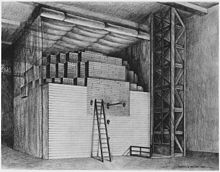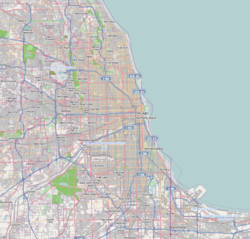
Back Chicago Pile-1 Afrikaans شيكاغو بايل -1 Arabic Chicago Pile-1 Czech Chicago Pile German Chicago Pile-1 Spanish شمع شیکاگو Persian Chicago Pile-1 French Chicago Pile-1 Galician Nuklearni reaktor CP 1 Croatian Chicago Pile-1 ID
| Chicago Pile-1 | |
|---|---|
 | |
| Reactor concept | Research reactor |
| Designed and built by | Metallurgical Laboratory |
| Operational | 1942 to 1943 |
| Status | Dismantled |
| Location | Chicago, Illinois, US |
| Main parameters of the reactor core | |
| Fuel (fissile material) | Natural uranium |
| Fuel state | Solid (pellets) |
| Neutron energy spectrum | Slow |
| Primary control method | Control rods |
| Primary moderator | Nuclear graphite (bricks) |
| Primary coolant | None |
| Reactor usage | |
| Primary use | Experimental |
| Criticality (date) | 2 December 1942 |
| Operator/owner | University of Chicago / Manhattan Project |
| Remarks | World's first artificial nuclear reactor |
Site of the First Self Sustaining Nuclear Reaction | |
| Coordinates | 41°47′33″N 87°36′4″W / 41.79250°N 87.60111°W |
| Built | 1942[2] |
| NRHP reference No. | 66000314[1] |
| Significant dates | |
| Added to NRHP | 15 October 1966 (66000314)[1] |
| Designated NHL | 18 February 1965[2] |
| Designated CL | 27 October 1971[3] |
Chicago Pile-1 (CP-1) was the world's first artificial nuclear reactor. On 2 December 1942, the first human-made self-sustaining nuclear chain reaction was initiated in CP-1 during an experiment led by Enrico Fermi. The secret development of the reactor was the first major technical achievement for the Manhattan Project, the Allied effort to create nuclear weapons during World War II. Developed by the Metallurgical Laboratory at the University of Chicago, CP-1 was built under the west viewing stands of the original Stagg Field. Although the project's civilian and military leaders had misgivings about the possibility of a disastrous runaway reaction, they trusted Fermi's safety calculations and decided they could carry out the experiment in a densely populated area. Fermi described the reactor as "a crude pile of black bricks and wooden timbers".[4]
After a series of attempts, the successful reactor was assembled in November 1942 by a team of about 30 that, in addition to Fermi, included scientists Leo Szilard (who had previously formulated an idea for non-fission chain reaction), Leona Woods, Herbert L. Anderson, Walter Zinn, Martin D. Whitaker, and George Weil. The reactor used natural uranium. This required a very large amount of material in order to reach criticality, along with graphite used as a neutron moderator. The reactor contained 45,000 ultra-pure graphite blocks weighing 360 short tons (330 tonnes) and was fueled by 5.4 short tons (4.9 tonnes) of uranium metal and 45 short tons (41 tonnes) of uranium oxide. Unlike most subsequent nuclear reactors, it had no radiation shielding or cooling system as it operated at very low power – about one-half watt.
The pursuit of a reactor had been touched off by concern that Nazi Germany had a substantial scientific lead. The success of Chicago Pile-1 in producing the chain reaction provided the first vivid demonstration of the feasibility of the military use of nuclear energy by the Allies, as well as the reality of the danger that Nazi Germany could succeed in producing nuclear weapons. Previously, estimates of critical masses had been crude calculations, leading to order-of-magnitude uncertainties about the size of a hypothetical bomb. The successful use of graphite as a moderator paved the way for progress in the Allied effort, whereas the German program languished partly because of the belief that scarce and expensive heavy water would have to be used for that purpose. The Germans had failed to account for the importance of boron and cadmium impurities in the graphite samples on which they ran their test of its usability as a moderator, while Leo Szilard and Enrico Fermi had asked suppliers about the most common contaminations of graphite after a first failed test. They consequently ensured that the next test would be run with graphite entirely devoid of them. As it turned out, both boron and cadmium were strong neutron poisons.
In 1943, CP-1 was moved to Site A, a wartime research facility near Chicago, where it was reconfigured to become Chicago Pile-2 (CP-2). There, it was operated for research until 1954, when it was dismantled and buried. The stands at Stagg Field were demolished in August 1957 and a memorial quadrangle now marks the experiment site's location, which is now a National Historic Landmark and a Chicago Landmark.
© MMXXIII Rich X Search. We shall prevail. All rights reserved. Rich X Search
